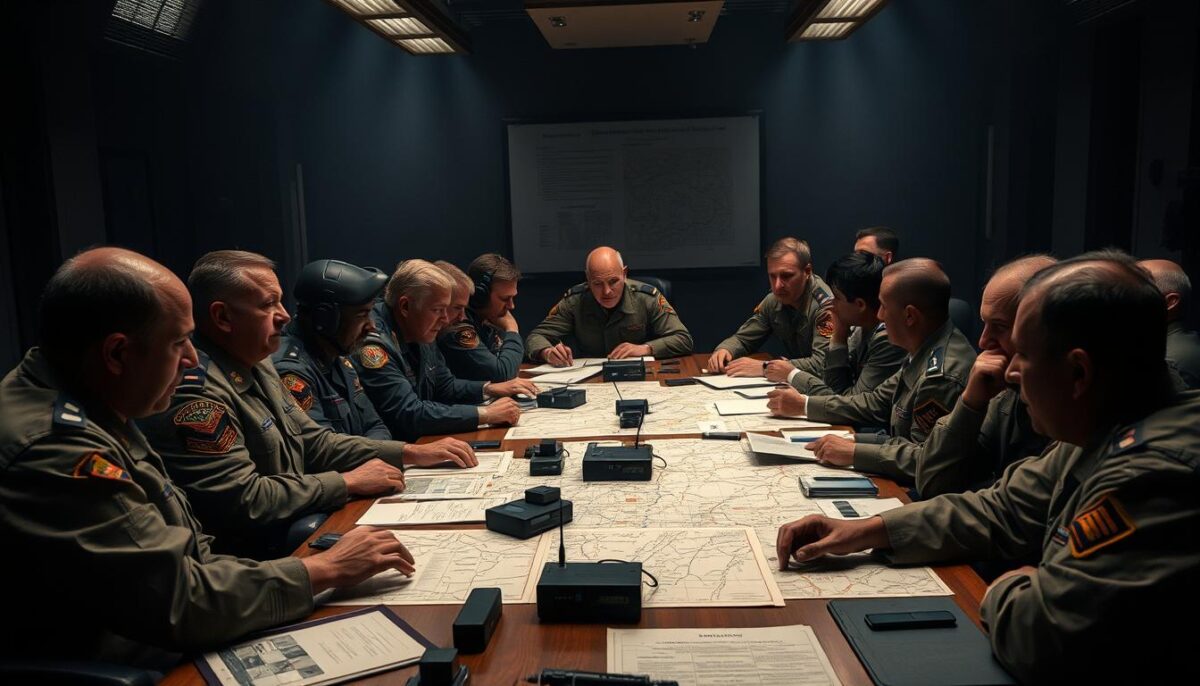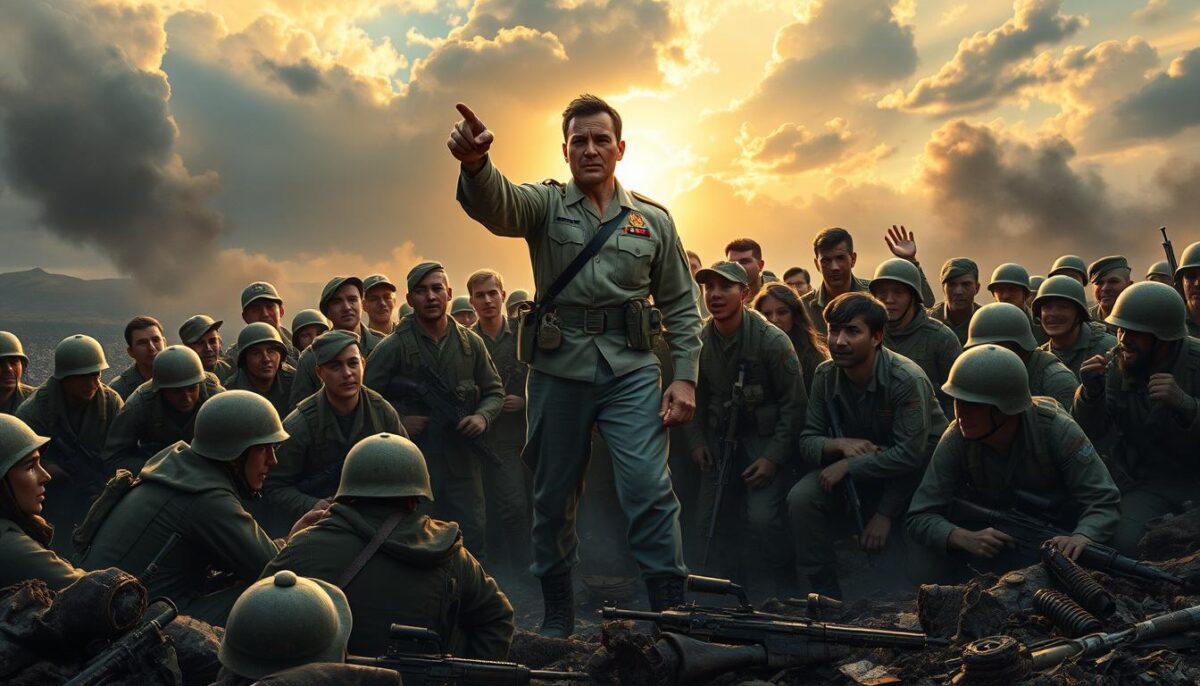Captain John H. Miller from “Saving Private Ryan” shows us key leadership lessons. His story teaches us about leading a team in tough times. He shows us how to be strong, empathetic, and make quick decisions.
His journey helps us understand how to build a strong team. Even when things get hard, he keeps his team together. This shows us how to inspire trust and unity.
Learning from Capt. Miller helps us be better in tough situations. He teaches us that leadership is about making hard choices and connecting with our team. This helps us create a place where everyone works together well.
By being empathetic, we can make our team more collaborative. This is key in managing complex situations. It helps us achieve our goals together.
For more insights, check out films like “Twelve O’Clock High” or “We Were Soldiers”. They offer different views on leadership.
The Leadership Model of Capt. Miller
Capt. Miller’s leadership model is great for anyone wanting to lead a team well. He believes in earning trust first. This trust helps the team work together, especially when things get tough.
Miller moves from fear to respect, giving his team a sense of purpose. True leaders need a clear goal, especially in tough times. He shows that leaders must earn respect by being reliable and trustworthy.
Good leaders do more than just manage tasks. They create a place where everyone feels they have a purpose. Miller is a great example of this. He is strong and cares for his team, leading them through tough times.
Understanding leadership is both a science and an art, as Miller shows. He is real and shows his human side, like shaking with stress. This makes his team want to follow him.
Miller is also honest and professional. He doesn’t complain about his bosses. This shows he is accountable and serious about growing. His honesty and integrity are key for making good decisions.
| Leadership Quality | Significance |
|---|---|
| Earning Trust | Foundation for collaboration and support |
| Authenticity | Fosters relatability and connection |
| Building Purpose | Inspires motivation beyond tasks |
| Accountability | Enhances credibility and respect |
| Decisiveness | Guides effective action in chaos |
In short, Capt. Miller’s leadership model is full of important qualities. He shows how to be empathetic and decisive. His leadership is a great example for today’s and tomorrow’s leaders.
What can leaders and managers learn from Capt. Miller
Capt. Miller’s leadership offers deep lessons for those in charge. He shows how empathy and clear decision-making work together. This mix greatly affects team work and success.
Empathy as a Leadership Quality
Empathy is key in Capt. Miller’s leadership. He understands and respects his team’s fears and weaknesses. This creates a supportive team that works better together.
His empathy builds trust and encourages everyone to speak up. This is especially important during tough times. It helps the team face challenges as one.
Importance of Clear Decision Making
Clear decision-making is crucial for success. Capt. Miller shows how to stay focused and make quick, smart choices. He balances empathy with decisiveness, a skill needed today.
His way of making decisions helps manage teams with different views. This is a valuable lesson for leaders.
| Leadership Traits | Capt. Miller’s Application | Impact on Team |
|---|---|---|
| Empathy | Recognizing soldiers’ fears | Builds trust and morale |
| Decisive Action | Clear commands during battles | Enhances team confidence |
| Vulnerability | Sharing personal struggles | Strengthens relationships |
| Communication | Maintaining a clear chain of command | Improves operational effectiveness |
By learning from Capt. Miller, managers can lead their teams better. These lessons are from his leadership and are useful in many fields.
Demonstrating Integrity Under Pressure
Integrity is key in leadership, especially when things get tough. Capt. Miller shows us what it means to be honest and open with his team. He makes tough choices and talks openly, even if it means losing trust for a bit.
This shows us important lessons that apply everywhere, not just in war. Leaders often face tough choices that test their ethics. Capt. Miller’s way of handling mistakes and owning up to decisions teaches us about accountability.
His leadership style teaches us that being honest and true, even when it’s hard, builds trust and loyalty. This way of leading shows that actions and beliefs should always match. It creates respect that lasts beyond urgent moments.
Capt. Miller’s openness about his personal life shows us the value of being real. Sharing his civilian side makes his team feel closer to him. This is important in both the military and business worlds, showing that integrity needs both strength and a human side.
In short, Capt. Miller’s integrity is a great example for today’s leaders. Being open, admitting mistakes, and focusing on ethics builds a strong team. By following these values, leaders can reach their goals and succeed in the long run.
Crisis Management Techniques Inspired by Capt. Miller
Crisis management needs special skills, especially when leading in chaos. Capt. Miller shows us how to manage well in tough times. His calmness inspires confidence in his team, which is key for leadership.
Leaders must be the voice of reason. They guide their teams through uncertainty and support them. This creates a positive atmosphere.
Leading in Chaotic Situations
Leaders face big challenges in crises. Capt. Miller teaches us to lead with clear direction and solutions. Talking to team members personally shows compassion and builds strong relationships.
It’s important not to complain up the chain. This can hurt morale. Instead, address issues laterally to keep things positive. Setting clear goals helps achieve short-term objectives, which is vital.
Maintaining Calm and Order
In crisis, calm leadership is crucial. Capt. Miller’s calmness inspires his team to stay calm too. Being polite and courteous can help solve conflicts, even in tough situations.
Building team spirit is also key. Successful teams stand together, no matter what. Leaders should stay open-minded and support their team. This way, everyone works together and improves their leadership skills.
Building a Cohesive Team
Team building is key to success, especially in tough situations. Capt. Miller shows how important it is to build trust and camaraderie. When everyone feels valued, goals become easier to reach.
Fostering Camaraderie
Camaraderie is vital for a strong team. Capt. Miller made his team feel like a family. They shared laughs and opened up to each other.
Studies show teams work better together. For example, Schneider Electric saw a 70% drop in overtime. This shows how teamwork boosts performance.
Creating Trust Among Team Members
Trust is the foundation of a good team. Capt. Miller made his team trust each other. This improved their relationships and how they communicate.
Teams that work together well do better. Texas Instruments Inc. in Malaysia saw a 30% productivity increase. This shows how teamwork leads to success.
Teams like Chico’s Retailer Services Inc. grew fast. They doubled their revenue in two years. This shows how teamwork and trust lead to success.
Successful leaders, like Capt. Miller, know the value of teamwork. They create an environment where everyone can do their best.
For more tips on team performance, check out this link. It has great advice on teamwork and leadership.
The Importance of Communication Skills
In high-stakes leadership, good communication is key. Capt. Miller shows how clear talk can lead a team. He explains the mission clearly to his team, making sure everyone knows the risks and plans.
His clear communication builds trust and confidence, even in tough times.
Effective Communication in High-Stakes Environments
Leaders in high-pressure situations need to be good at many things. This includes body language, talking, and listening well. A study from “Communication Skills for Effective Management” says leaders use many skills to do well.
- Clear instructions help avoid mistakes in tasks.
- Listening well helps get feedback and creates a supportive team.
- Clear roles and expectations make team members more accountable.
Capt. Miller’s skill in sharing important info under pressure is crucial. His way of communicating boosts team spirit and helps finish projects faster. This is very important in high-stakes situations.

Communication skills and leadership go hand in hand. Those who are good at communicating often lead the way. They face challenges with confidence and clarity.
Exhibiting Courage as a Leader
Capt. Miller shows true courage in leadership. He faces danger head-on, earning loyalty and respect from his team. This teaches managers that courage means making tough choices and staying true to values.
Being brave helps leaders build trust and resilience. Talking openly and positively with the team strengthens bonds. This approach boosts morale and performance.
Looking at Capt. Miller’s lessons, I see the importance of team development. This creates a culture of bravery, where everyone can act boldly when needed.
Motivation Techniques from Capt. Miller
Capt. Miller is great at motivating his team. He knows how to make them feel understood and united. He talks about their fears and worries, making them feel heard and strong.
Encouraging Team Members During Adversity
Capt. Miller builds strong bonds with his team. These bonds make them more loyal and willing to help out. He shows them that their feelings matter, making them ready to face tough times.
He makes the mission’s purpose clear, even in hard times. This turns challenges into chances for growth. It shows everyone how important their work is in overcoming hurdles.
As he gets to know his team better, Capt. Miller becomes a better leader. He uses his charm and care for each person to make them feel special. This makes his team stay motivated and work together, even when things get tough.
Adapting Leadership Styles to Situations
Good leaders change their plans as needed. Capt. Miller shows this with his flexible leadership. He decides when to lead strongly and when to listen more, based on the situation.
Learning to lead better is key. We need to work on solving problems, listening well, and managing groups. These skills help us boost productivity and teamwork. Activities like coaching and workshops give us tools for leading every day.
Looking at how we lead is important. We should check our strengths and weaknesses and set goals for growth. Knowing our leadership style helps us in tough times when we need to be flexible.
Games like Playing with Status show how leadership styles affect us. Most leaders use a mix of styles. Learning to switch between them helps us communicate better and keep our teams together.
Leadership is complex and always changing. Capt. Miller’s story teaches us to be adaptable and aware of our team’s needs. In today’s fast-paced world, being flexible is not just good—it’s essential.

Learning from Mistakes: A Leadership Perspective
Good leadership is not just about reaching goals. It’s also about learning from mistakes. Capt. Miller shows us how to do this by owning up to errors. His way of leading shows us why being open is key.
By looking at both wins and losses, leaders can help their teams grow. This way, everyone can learn and get better together.
Owning Up to Errors
Capt. Miller’s story teaches us that learning from mistakes is crucial for leaders. His experiences are valuable, especially for those who aim to be great leaders. He has over 50 years of leading, showing us timeless lessons.
Regular checks, like the 360-degree reviews in the federal government, are important. They help leaders stay accountable. Capt. Miller’s story reminds us that admitting mistakes builds trust and helps us improve.
Films like *Saving Private Ryan* also teach us about leadership. The movie shows us how to learn from crisis moments. Watching these movies helps us understand leadership better and why we must face mistakes.
Role of Vulnerability in Leadership
In leadership, vulnerability in leadership can bring big benefits. Capt. Miller shows how being open about weaknesses helps teams bond. This honesty builds trust.
Being vulnerable is not weak; it’s strong. Dr. Brené Brown’s TED talk on vulnerability has reached millions. It shows we like imperfections.
Being open about mistakes helps build trust. It makes teams feel safe to share their struggles. This openness is key for growth.
| Aspect | Vulnerability Benefits | Leadership Outcomes |
|---|---|---|
| Team Engagement | Higher openness to share experiences | Enhanced creativity and innovation |
| Trust Levels | Stronger interpersonal connections | Improved team cohesion |
| Anxiety Reduction | Less fear of judgment | Lower stress levels among leaders |
| Personal Growth | Encourages self-reflection | Increased capability and adaptability |
Embracing vulnerability in leadership brings big wins. Capt. Miller’s way shows how to build trust and strength in teams. This makes teams more resilient and effective.
The Face of Purpose in Leadership
Capt. Miller shows us a new way of leading, moving away from fear to purpose. When faced with tough times, he shares his teaching past. This gives his team a new purpose.
This moment shows how purpose motivates and unites teams. It helps them get through hard times together.
Leadership is about having a clear purpose. Capt. Miller’s story teaches us that a clear vision inspires and unites. It makes teams strong and united, especially when things get tough.
Being true and open is key in leadership. Leaders must show their true intentions. Capt. Miller’s story reminds us to live our visions, not just talk about them.
For more on leadership, check out this link: leadership insights.

